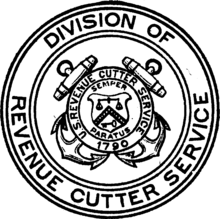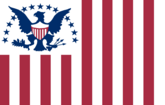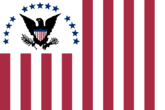U.S. Revenue Cutter Service
| United States Division of Revenue Cutter Service | |
|---|---|

Seal of the United States Revenue Cutter Service
|
|
| Active | 4 August 1790 – 31 July 1894 (as the U.S. Revenue-Marine) 31 July 1894 – 28 January 1915 (as the U.S. Revenue Cutter Service) |
| Country |
|
| Role | Maritime law enforcement |
| Part of |
|
| Nickname(s) | "U.S. Revenue-Marine" (1790-1894) "U.S. Revenue Cutter Service" (1894-1915) |
| Motto(s) | "Semper Paratus" (English: "Always Ready") |
| Anniversaries | 4 August |
| Disbanded | 28 January 1915 |
| Insignia | |
| Ensign (1799) |  |
| Ensign (1815) |  |
| Ensign (1836) |  |
| Ensign (1841) |  |
| Ensign (1867) |  |
| Ensign (1868) |  |
The United States Revenue Cutter Service was established by an act of Congress (1 Stat. 175) on 4 August 1790 as the Revenue-Marine upon the recommendation of Secretary of the Treasury Alexander Hamilton to serve as an armed customs enforcement service. As time passed, the service gradually gained missions either voluntarily or by legislation, including those of a military nature. It was generally referred to as the Revenue-Marine until July 1894, when it was officially renamed the Revenue Cutter Service.
The Revenue Cutter Service operated under the authority of the U.S. Department of the Treasury. On 28 January 1915, the service was merged by an act of Congress with the United States Life-Saving Service to form the United States Coast Guard.
Immediately after the American Revolutionary War the new United States was struggling to stay afloat financially. National income was desperately needed, and the government determined that a great deal of this income would come from tariffs on imports. Because of rampant smuggling, the need was immediate for strong enforcement of tariff laws. On 4 August 1790, the United States Congress, urged on by Secretary of the Treasury Alexander Hamilton, created the Revenue-Marine, later renamed the Revenue Cutter Service by act of 31 July 1894 (28 Stat. 171).
A cutter vessel is a small or medium-sized boat or sailing ship, built for speed and with a shallow draught. While some larger cutters had two or three masts, many cutters had only one, located more centrally on the ship than was typical of larger vessels. In modern times, any naval ship built for speed and agility is still referred to as a cutter.
...
Wikipedia
